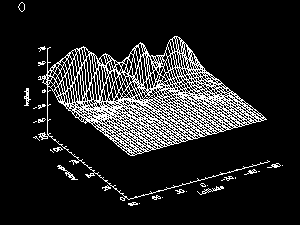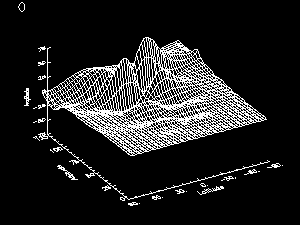
Animation cycles ten times (ten solar days). [ESC] to stop, Reload to replay.

This animated wave is the sum of the semidiurnal (below, L) and diurnal (below, R) meridional migrating tides. The axes are: Latitude (degrees, North to South); Altitude (km); Amplitude (m/s). The number in the upper left is the local time in hours.


This pattern is repeated for all longitudes in the time- independent (migrating) solution, so a "top" view of latitude vs. longitude would be similar to the January meridional tide, with the appropriate seasonal adjustments seen in the April tides (see links, below). The surface mesh plot shows the wave action more graphically than a contour plot.
The four daily maxima (two positive, two negative) of the semidiurnal wave dominate this combination of harmonics near the poles, while the equatorial regions show an enhancement of the diurnal peaks there.
The "top view" at 100km of the April semidiurnal meridional winds shows the two cycles of the semidiurnal tide in contour animation, or the single diurnal cycle.